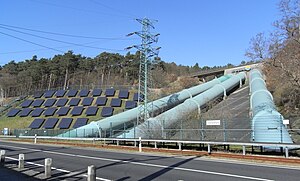Energy storage methods
Main articles: Grid energy storage and V2G
This energy park in Geesthacht, Germany, includes solar panels and pumped-storage hydroelectricity.

Seasonal variation of the output of the solar panels at AT&T Park in San Francisco
Solar energy is not available at night, making energy storage an important issue in order to provide the continuous availability of energy.
[79] Both wind power and solar power are intermittent energy sources, meaning that all available output must be taken when it is available and either stored for
when it can be used, or transported, over transmission lines, to
where it can be used. Wind power and solar power tend to be somewhat complementary, as there tends to be more wind in the winter and more sun in the summer, but on days with no sun and no wind the difference needs to be made up in some manner.
[80] The Institute for Solar Energy Supply Technology of the University of Kassel pilot-tested a combined power plant linking solar, wind, biogas and hydrostorage to provide load-following power around the clock, entirely from renewable sources.
[81]
Solar energy can be stored at high temperatures using molten salts. Salts are an effective storage medium because they are low-cost, have a high specific heat capacity and can deliver heat at temperatures compatible with conventional power systems. The Solar Two used this method of energy storage, allowing it to store 1.44 TJ in its 68 m³ storage tank, enough to provide full output for close to 39 hours, with an efficiency of about 99%.
[82]


No comments:
Post a Comment